|
| Links | Identification Tips:
The female is unique among eastern Ceratina in that they have a tiny white or ivory mark at the very apical end of the front femur. This is often overlooked as it is so close to the white mark on the adjacent tibia. The other Ceratina species have the ends of the femur dark. Males are unique for there very tiny flange on T7, small size, and the white stripe on the front tibia runs the Entire length of the tibia.
- Hosts
|
80x5 -
240x3 -
240x4 -
320x1 -
320x2 -
320x3 -
640x1 -
640x2
Set display option above.
Click on
images to enlarge. |
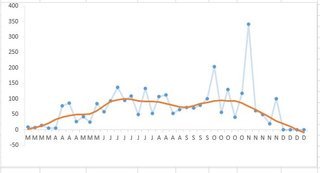
© Copyright source/photographer
· 9
Ceratina strenua, Mid-Atlantic Phenology |
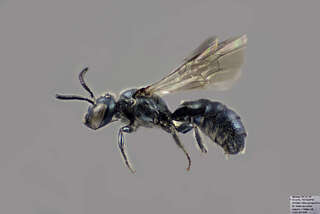
© Copyright source/photographer
· 9
Ceratina strenua, male side, high res |
|
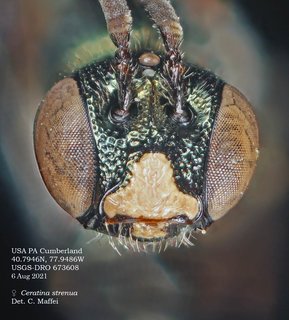
© Copyright source/photographer
· 9
Ceratina strenua, female, head |
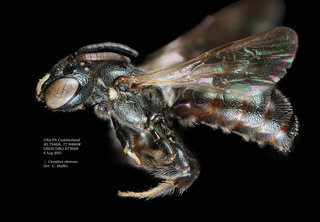
© Copyright source/photographer
· 9
Ceratina strenua, female, lateral |
|
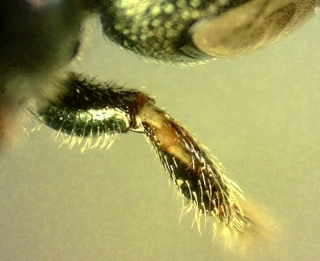
Deana M. Crumbling · 9
Ceratina strenua, female, foretibia maculation |
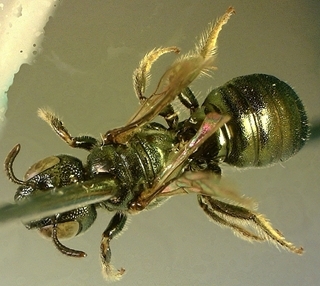
Deana M. Crumbling · 9
Ceratina strenua, female wh body |
|
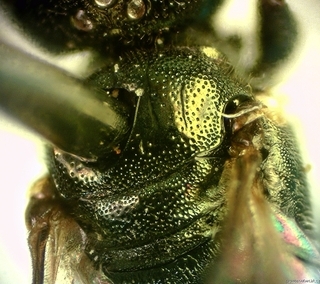
Deana M. Crumbling · 9
Ceratina strenua, female, parapsidal line |
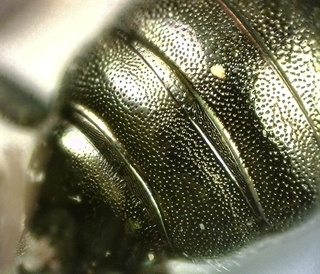
Deana M. Crumbling · 9
Ceratina strenua, female T1-3 |
|
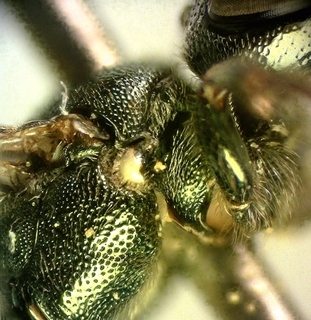
Deana M. Crumbling · 9
Ceratina strenua, female, tubercle |
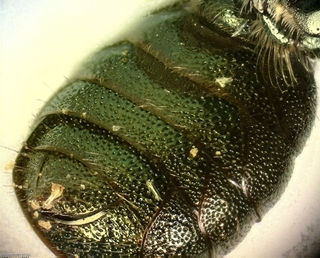
Deana M. Crumbling · 9
Ceratina strenua, female, ventral abd |
|
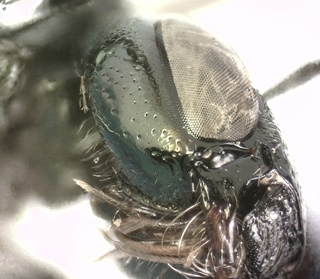
Deana M. Crumbling · 9
Ceratina strenua, female, cheek |
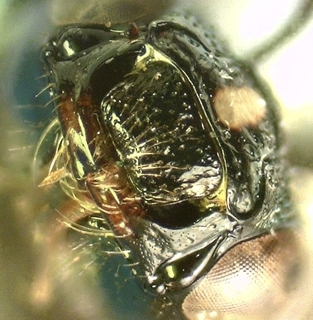
Deana M. Crumbling · 9
Ceratina strenua, mandibles |
|
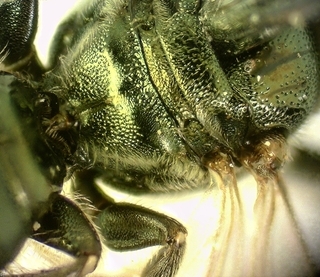
Deana M. Crumbling · 9
Ceratina strenua, female, dorsal thorax |
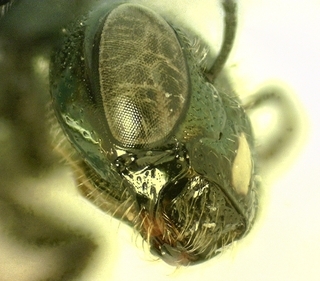
Deana M. Crumbling · 9
Ceratina strenua, female, mandible 2 |
|
Overview |
Reprinted with permission from: Mitchell, T.B. 1962 Bees of the Eastern United States. North Carolina Agricultural Experiment Station Technical Bulletin No. 152.
FEMALE----- 5-6.5 mm.; general body color blue-green, antennae becoming brownish apically, clypeus with a median, oblong, ivory maculation; mandibles somewhat reddish; legs piceous, with some metallic reflections, the apical tarsal segments becoming testaceous; basal two-thirds of front tibiae with an outer, ivory maculation; mid and hind tibial spurs pale yellowish; tegulae yellowish-hyaline; wings subhyaline, veins testaceous to brownish; tubercles bright yellow in both sexes; cheeks slightly narrower than eyes; clypeus quite flat, the median length somewhat more than half the apical width; mandibles distinctly tridentate at apex; antennal segments 2-5 considerably broader than long; clypeus largely impunctate medially, with some irregular, scattered punctures on each side; face shining, an impunctate polished area below ocelli, punctures otherwise rather coarse but irregular, rather close on each side below, those in median area sparse in general, becoming closer above on vertex, close and fine on cheeks above, very sparse and minute below; thoracic punctures much finer than those on head, scutum quite sparsely punctate between notaulices, becoming rather closely punctate anteriorly and posteriorly; scutellum with fine, well separated punctures, those on pleura somewhat coarser but well separated; lateral faces of propodeum minutely and densely punctate, becoming more shallow and obscure but still close posteriorly, dorsal area narrowly striate along upper margin; punctures of abdominal terga fine, but deep and distinct, well separated medially on 2-4 where interspaces are considerably greater than diameter of punctures; pubescence entirely pale, very short and thin, somewhat more evident on thorax laterally, on legs, and on the more apical abdominal terga.
MALE—Length 4.5-5 mm.; general body color metallic blue-green, clypeus ivory except for the very narrow lateral margin, and labrum with a quadrate, median, ivory maculation; antennae brownish beneath, more piceous above; legs largely blackish, with metallic reflections, the apical tarsal segments becoming somewhat more brownish, front tibiae with an ivory stripe along outer margin nearly to tip; spurs pale yellow; tegulae testaceous-hyaline; wings hyaline, veins testaceous to brownish; tubercles bright yellow in both sexes; cheeks somewhat narrower than eyes; clypeus quite flat, median length somewhat less than apical width; mandibles with a small, subapical tooth on lower margin; segments 2 and 3 of flagellum much broader than long; clypeus nearly impunctate, punctures of face otherwise quite coarse but rather shallow, quite close below antennae, becoming somewhat deeper and not so close above, fine and sparse on cheeks below: thoracic punctures much finer than those on head, quite sparse on scutum medially, well separated on scutellum medially, quite close over most of pleura, very fine and close on lateral faces of propodeum, becoming more sparse, shallow and obscure posteriorly, dorsal face narrowly and finely striate along upper margin; discs of abdominal terga with rather fine but deep and distinct punctures, quite close in general but interspaces across median portion of 2 and 3 somewhat greater than diameter of the punctures; hind femora conspicuously angulate beneath, width at this point fully half the length; carina of tergum 7 very narrow, its median length nearly equal to the basal width; pubescence entirely pale, very short, thin and inconspicuous; apical margin of sternum 6 with a deep, median emargination bearing a pair of short but robust, peg-like processes, and a more median, minute pair which are only partially separated; sternum 7 and genital armature much as in calcarata (fig. 124).
DISTRIBUTION—New York to Georgia and Louisiana, March to September.
FLOWER RECORDS—Asclepias, Chrysanthemum, Fragaria, Geranium, Helianthus, Oenothera, Prunus, Rubus, Senecio and Vaccinium.
|
|
|
Names | |
|
|
| Supported by | |
Updated: 2024-05-05 05:29:04 gmt
|